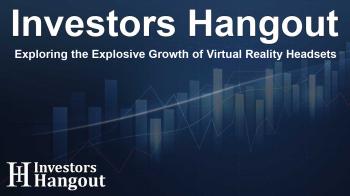Exploring the Explosive Growth of Virtual Reality Headsets

Unleashing the Potential of Virtual Reality Headsets
The virtual reality (VR) headset market is witnessing a remarkable transformation, fueled by the rising demand for immersive technologies. As consumers and industries alike embrace VR, projections indicate this market could reach an impressive USD 75.04 billion by the end of the forecast period. The estimated growth rate stands at a staggering CAGR of 23.96% from a valuation of USD 10.99 billion in 2023.
Trends Driving the Market Forward
Significant growth in the VR headset market is largely attributed to advancements in display technology, real-time interaction, and high-speed internet connectivity like 5G. The United States is leading this revolution, with the VR headset market poised to surge from USD 1.88 billion to USD 13.79 billion by 2032, showcasing a CAGR of 24.92%. Industries such as gaming, healthcare, and enterprise training are the key drivers behind this spike, with VR creating new avenues for experiences and training processes in these sectors.
Consumer Demand for Immersive Gaming
Consumers, particularly younger demographics such as millennials and Gen Z, are fueling the demand for VR within the gaming industry. The gaming segment accounted for 29.76% of VR revenue in 2023, emphasizing how VR not only enhances gameplay but also facilitates immersive experiences through evolving technology. As more VR-compatible games are developed, industry stakeholders are working hard to create compelling gaming environments that resonate with users.
The Rise of Education and Training Applications
While gaming currently dominates the VR space, educational applications are emerging as a rapidly growing segment. With more institutions adopting VR for remote learning and virtual simulations, the education sector is expected to show the fastest growth rate. Trained educators can utilize VR to enhance engagement in STEM subjects, medical training, and historical reenactments, making learning more interactive and effective.
A Closer Look at Major Players
Several prominent companies are making significant headway in the VR market, bringing innovative products and solutions to consumers. Notable players include:
- Carl Zeiss AG with the flagship ZEISS VR One Plus,
- Facebook Technologies, LLC (Oculus) with Oculus Rift and Quest series,
- Google LLC offering accessible options like Google Cardboard,
- HTC Corporation with the HTC Vive series,
- Meta Platforms Inc. leading with the Meta Quest 3 and Pro models.
These companies are leveraging their technological expertise to shape the growth trajectory of VR headsets, focusing on enhancing user experience and accessibility.
Understanding User Preferences: Product Types
The market can be divided primarily into two segments based on product types: standalone and smartphone-enabled headsets. Standalone headsets, which do not rely on additional external devices, dominate the market with a 43.29% market share as of 2023. Meanwhile, smartphone-enabled headsets are gaining momentum due to cost-effectiveness and the increasing penetration of advanced smartphones.
Geographical Trends in VR Adoption
The geographical landscape for VR headset adoption is as diverse as it is expansive. The Asia-Pacific region holds the largest market share due to the widespread adoption of VR technology in Japan, China, and South Korea. Conversely, North America is projected to experience the fastest growth rate, highlighting the region's commitment to investing in the latest VR development.
Conclusion: A Future Rich in Possibilities
The VR headset market is on the brink of explosive growth, driven by an impressive array of applications, advancements in technology, and an evolving consumer base eager for experiential innovation. By harnessing the power of immersive technology, businesses and educators alike can explore impactful insights and opportunities, enriching user experiences across multiple domains, from gaming to training and beyond.
Frequently Asked Questions
What is driving the growth of the VR headset market?
The growth is primarily driven by advancements in technology, increased demand in gaming, healthcare, and training, along with more consumers seeking immersive experiences.
Which market segment currently leads in terms of revenue?
The gaming segment rose to prominence, accounting for a significant share of VR revenue, as immersive gameplay attracts a diverse audience.
How is VR technology changing education?
VR provides immersive environments that enhance learning experiences, allowing for real-time simulations and interactive lessons, particularly in STEM education.
Who are the major players in the VR headset market?
Key players include Carl Zeiss AG, Facebook Technologies, Google LLC, HTC Corporation, and Meta Platforms among others, contributing innovative solutions to the market.
What regions are leading in VR adoption?
Asia-Pacific currently dominates the market, while North America is expected to have the fastest growth rate, driven by technological advancements and investment in VR.
About The Author
Contact Owen Jenkins privately here. Or send an email with ATTN: Owen Jenkins as the subject to contact@investorshangout.com.
About Investors Hangout
Investors Hangout is a leading online stock forum for financial discussion and learning, offering a wide range of free tools and resources. It draws in traders of all levels, who exchange market knowledge, investigate trading tactics, and keep an eye on industry developments in real time. Featuring financial articles, stock message boards, quotes, charts, company profiles, and live news updates. Through cooperative learning and a wealth of informational resources, it helps users from novices creating their first portfolios to experts honing their techniques. Join Investors Hangout today: https://investorshangout.com/
The content of this article is based on factual, publicly available information and does not represent legal, financial, or investment advice. Investors Hangout does not offer financial advice, and the author is not a licensed financial advisor. Consult a qualified advisor before making any financial or investment decisions based on this article. This article should not be considered advice to purchase, sell, or hold any securities or other investments. If any of the material provided here is inaccurate, please contact us for corrections.

